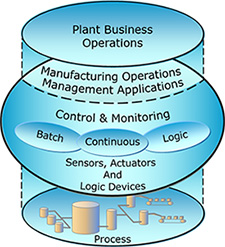ARC's Vision for Future Distributed Control Systems
More than ever, owner/operators in today's process industries require automation systems that can help them maximize their return on assets to achieve business advantage, while reducing the cost and effort needed to comply with myriad governmental regulations.
Collaborative Process Automation System or CPAS is our vision of future process control systems. ARC introduced the CPAS concept in 2002 in response to requests from several large end user clients that were having difficulty evaluating the capabilities of the current Distributed Control Systems (DCS) to meet their evolving business requirements. In order to meet these evolving process automation requirements, ARC analysts first established a set of guiding principles to develop our vision. We used these guiding principles to create the functional requirements, architecture, and technology choices. Some of the guiding principles used to develop our vision are briefly described in the following paragraphs:
Return on Assets (ROA)
ARC believes process automation offers the potential to deliver significant higher return on assets (ROA) during the life cycle of a process plant. However, most users purchase process automation systems to stay technologically current and reduce total cost of ownership (TCO), rather than to achieve continuous improvement and associated economic gains. Unfortunately the project-oriented nature of acquiring automation tends to mask appreciation for the true contribution process automation systems can make to ROA. This is because the project ends before the contribution is realized and overall project ROA does not recognize benefits achieved from process automation. The absence of a return on investment (ROI) feedback mechanism and a common basis for measuring performance between business and manufacturing systems further complicates the issue.
The Race for Operational Excellence (OpX) 
Operational excellence is the first supporting layer to ROA. Operational excellence delivers measurable performance improvements by focusing on doing more with less as well as working more effectively and reducing cost. OpX results from more people making more correct decisions. The OpX continuous improvement methodology reinforces the concept that OpX is an ongoing process.
Effectiveness, Agility, and Visualization
Effectiveness, agility, and performance visualization are keys to operational excellence. Effectiveness and agility support the principle of flawless operation. Research shows that, on average, most process plants operate at less than Four Sigma performance levels.
Automate and Empower
By automating everything that should be automated, you ensure that manual tasks will always be executed based on best practices. Automation also frees up time for worker empowerment, providing these knowledge workers with the opportunity to perform more value-adding functions.
Automation Asset Management
Because CPAS is based on standards, it can support a mixed supplier environment, with each application having its own configuration and system management facility. Traditionally, each DCS/PAS employed a proprietary system and configuration management environment. CPAS provides an open platform and a mixed supplier environment. In this environment, each application retains its own system and configuration management, but a unified automation asset management facility for configuration management and system health addresses the issue of multiple system and configuration facilities. Configuration management includes an audit trail, priority access, and failsafe configurations for all applications and devices in the system. Ultimately, this function will become part of the operating system as an advanced application executive.
Data Certainty and Traceability
Data and information represents CPAS‘ blood flow. However, at any point in time, up to 10 percent of the field device-based signals in any system can be inaccurate for one reason or another. Therefore, it is important for this data to have associated quality tags. Dependent variable data should also have quality tags. The regulated industries require that product constituents can traced through their processes, thus CPAS also accommodates traceability functions.


